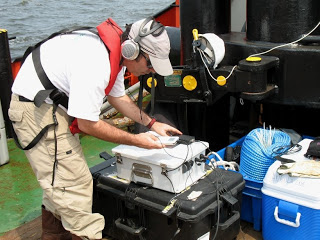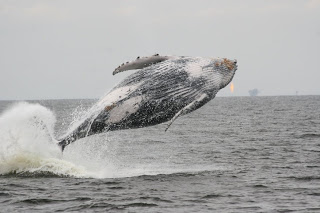Outrageous Whale Day!
Another component of the whale work here is the deployment and recovery of acoustic recording devices (called Marine Autonomous Recording Units or MARUs, developed by Cornell University Ornithology Lab, Bioacoustics Research Program) to record whale song. Actually they continuously record everything 24/7 while they’re deployed, but the goal is to record whales. The devices are really cool (I wrote about the same devices being used for elephants in Gabon, see my posting from 11/2/07) but very expensive ($20,000 each, which makes $6000 manatee GPS tags seem cheap by comparison!), so Sal is understandably always a bit nervous about getting the deployments and recoveries to go off smoothly. I think this trip is the third recovery/re-deployment for this project, but it’s the first time I’ve been here to see it.
While Warren and I were busy sampling manatee bones on 8/20, Sal and Tim recovered 3 MARUs offshore where they had been deployed in the submarine canyon at the Congo River mouth. On 8/21 they spent the day downloading data that was recorded over the past couple months, then refurbishing them with new batteries and other parts to be re-deployed on 8/22.
Here’s Sal working on one of the MARUs. The equipment is housed in a very thick glass sphere to withstand pressure at over 100m depth. When deployed, the entire unit is also covered with a heavy yellow plastic housing.
 On the morning of 8/22 we headed back offshore for the re-deployment. The ocean was almost as calm as a lake which made for a perfect day (those of you who know my susceptibility to seasickness will understand why a calm day is critical for my ability to function at sea!). Two MARUs were deployed without a hitch, and then we used the rest of our time to look for whales.
On the morning of 8/22 we headed back offshore for the re-deployment. The ocean was almost as calm as a lake which made for a perfect day (those of you who know my susceptibility to seasickness will understand why a calm day is critical for my ability to function at sea!). Two MARUs were deployed without a hitch, and then we used the rest of our time to look for whales.

Sal can also communicate with the MARUs by sending a specific series of acoustic signals sent out from an underwater speaker he brings onboard the ship.
 We hit the jackpot when we saw a humpback repeatedly breaching a couple kilometers away. Shortly after we boated near to it, it was joined by a second whale and for the next couple hours they put on a display that was the cetacean equivalent of the finale of Fourth of July fireworks! Time after time they breached, barrel-rolled and tail-slapped right in front of the boat. There was also some mating activity, but this happens mostly underwater, so we didn’t witness any whale porn. Needless to say, between Tim, Sal and I, we have well over 1000 photos. Here’s a sampling of a couple of my favs:
We hit the jackpot when we saw a humpback repeatedly breaching a couple kilometers away. Shortly after we boated near to it, it was joined by a second whale and for the next couple hours they put on a display that was the cetacean equivalent of the finale of Fourth of July fireworks! Time after time they breached, barrel-rolled and tail-slapped right in front of the boat. There was also some mating activity, but this happens mostly underwater, so we didn’t witness any whale porn. Needless to say, between Tim, Sal and I, we have well over 1000 photos. Here’s a sampling of a couple of my favs:

This whale must’ve tail-slapped at least 20 times in a row, while the other one barrel-rolled next to it.
 This is what it looks like when 40 tons of whale goes airborne…
This is what it looks like when 40 tons of whale goes airborne… And this is what it looks like when that same 40 tons hits the deck!
And this is what it looks like when that same 40 tons hits the deck!

What a great way to spend my last day at Kwanda base!

WOW Lucy!!! These pics are amazing. I love to check your blog out. I miss working with you.. Ever need another intern for a short trip.. let me know!!!!
You better stop by for a visit when you get back to the states…
Love ya!